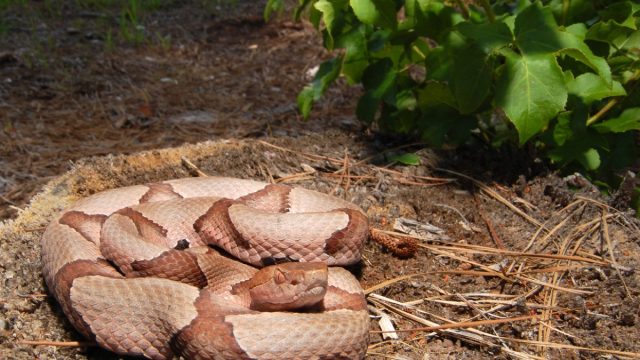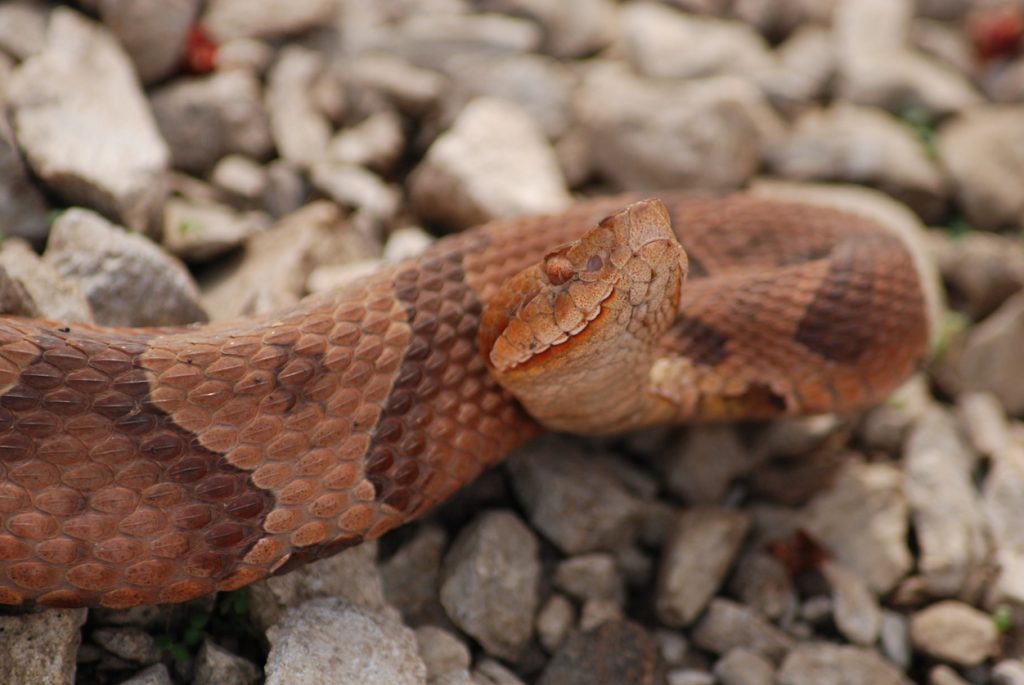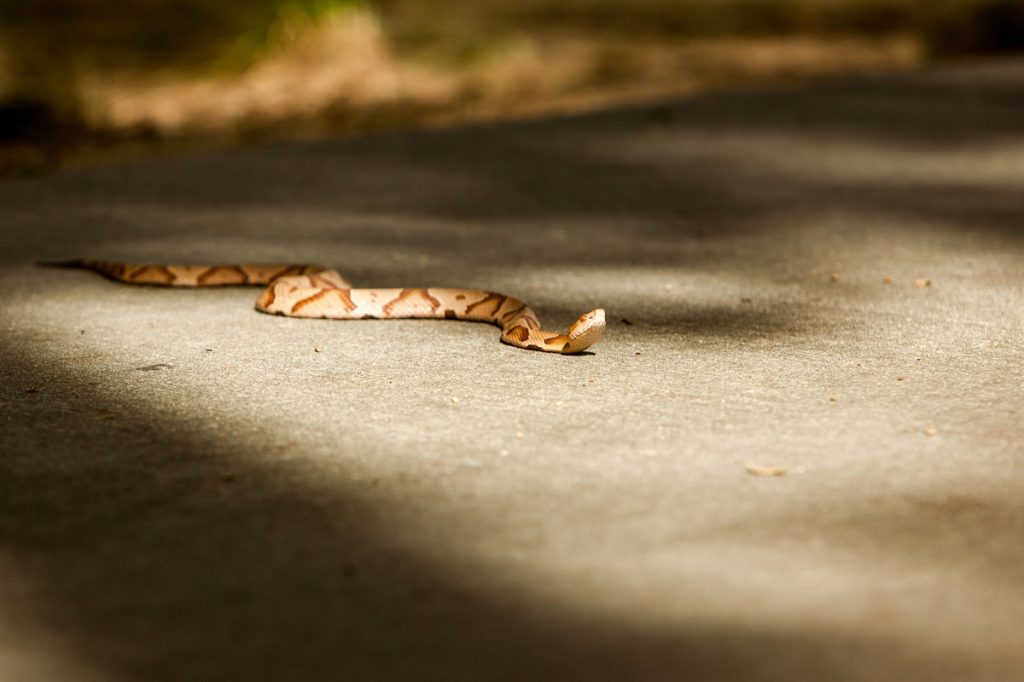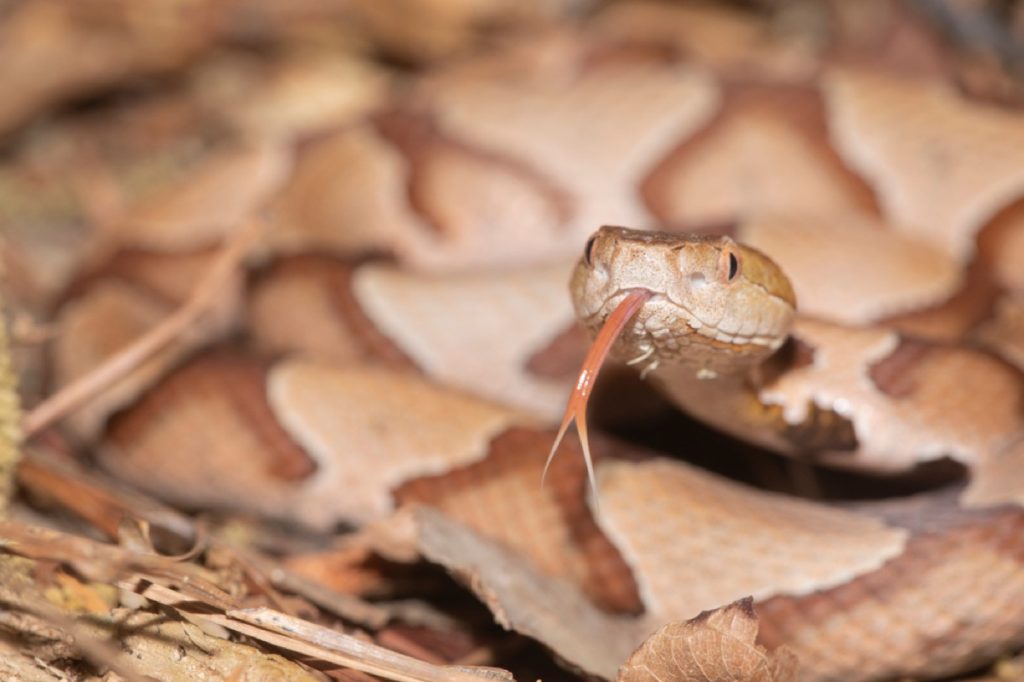Experts Warn Copperhead Sightings Are on the Rise: “They Don’t Act Like Other Snakes”

Whether they’re darting across your garden or resting on the hiking trail, there’s a good chance you’ve come across a snake at least once while outdoors. Fortunately, most species are completely harmless and often do their best to hide or stay out of our way. But if you live in an area with venomous species, it’s essential to know the risks they can pose to avoid any serious injuries—especially as warmer weather makes both humans and snakes more active. And now, experts are warning that copperhead sightings are on the rise in some areas. Read on to see what you need to know to keep yourself safe.
READ THIS NEXT: Keeping This Outside Will Attract Snakes to Your Yard, Experts Say.
The return of copperhead season has brought a spike in snake sightings.

The return of spring means the return of blossoming flowers and budding foliage. But the warm weather also marks the beginning of snake season—and the appearance of more snakes, including the venomous copperhead. And thanks to an earlier start this year, some animal control experts say they’re already experiencing a spike in calls to deal with the reptiles.
“They are my number one request for removal—we are going into copperhead season. August will be crazy, like eight calls a day,” Talena Chavis, wildlife control agent and founder of NC Snake Catcher, told local Raleigh, North Carolina CBS affiliate WNCN.
As more people head outside and snakes become more active, Chavis adds that copperheads stand out as a unique species besides the fact they’re common in her area. “I put them in their own classification, they don’t act like other snakes,” she told the news outlet. “It’s those differences that people don’t anticipate that lead to more issues.”
The snakes behave in a way that makes them more likely to have a run-in with humans.

Copperheads’ camouflage can make them notoriously hard to spot in the wild, especially when curled up in a pile of leaves or dense brush. But Chavis says that while the species isn’t at all aggressive, she also doesn’t consider it to be particularly shy or fearful of human areas such as hiking trails—or even a front porch.
“I think the majority of the time they get stepped on because they’re not seen,” Chavis told WNCN.
The increased likelihood of interaction also might come down to more than their tough-to-spot appearance. She explains that human impacts on the environment have brought us closer together, including our brightly lit homes built in their habitat. Since copperheads seek out the bugs and small rodents attracted to the brightness, the conditions can create something of a stable feeding ground for the reptiles.
“Some of our snakes have learned to associate light with, ‘If I follow this, I will find food at the end,'” Chavis told WNCN, likening it to a “dinner bell.”
RELATED: For more up-to-date information, sign up for our daily newsletter.
The snakes are facing fewer natural predators, which could be allowing their numbers to grow.

Despite human encroachment on their natural habitat and warmer weather, the recent spike in sightings might have to do with copperheads’ resiliency as a species. But other natural changes in the area could also be helping to drive their numbers up.
“The fact that we don’t have eastern kingsnakes in this area anymore has contributed to why we have so many copperheads,” Chavis said. “You remove an apex predator, and now you have a bunch.”
Ironically, increased human activity hasn’t seemed to hamper copperheads from getting comfortable, either. “These are our only venomous snakes that are not declining in number. I attribute that to their adaptability. They have completely adapted to suburban living,” Chavis told WNCN.
Here’s what you should do if you’re ever bitten by a copperhead or any other type of snake.

Unfortunately, some consequences can arise from cohabitating with copperheads. Charles Gerardo, MD, an emergency medicine specialist at Duke University Hospital, tells WNCN that a typical season sees 30 to 65 bites between April and August. So far, he says there have already been five—including one “odd bite” in January.
“Every year, as the weather begins to warm up, both snakes and people become more active, so we’ve had a lot more encounters,” Gerardo told WNCN.
Chivas says besides protective measures such as wearing boots when walking outdoors around your home, avoid trying to kill or capture the reptiles as that’s when most bites occur. But experts point out that if you do end up on the wrong end of a run-in, you should seek out medical attention right away.
“Just get to the hospital, remove anything constrictive, and elevate the affected limb,” Spencer Greene, director of toxicology at HCA Houston Healthcare-Kingwood in Texas, told The Houston Chronicle. Victims should also avoid using tourniquets or anything else restrictive to the bite area since it could do more harm. And if safely possible, try to take a photo of the snake so medical staff can attempt to identify it, he suggests.